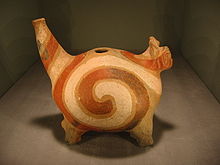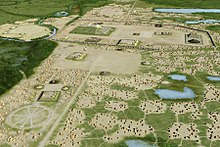Mississippian culture
The Mississippian culture was an Indian culture that appeared from about 900 AD and emerged from the Woodland period. Its center was on the middle Mississippi River. It extended to the southeastern part of what is now the United States, roughly covering the states of Alabama, Arkansas, Georgia, Illinois, Indiana, Louisiana, Kentucky, Michigan, Missouri, Oklahoma, Tennessee, and Texas. Contacts with the people at the headwaters of the Mississippi River in southern Wisconsin beginning about 1050, through which cultural techniques spread northward, coincide with the collapse of the Effigy Mounds culture there.
In addition to hunting and fishing, the Indians of the Mississippi culture also practiced agriculture. Among other things, corn and beans were cultivated. Dogs and turkeys were kept as farm animals. They also made richly decorated pottery. As the only Indian culture north of Mexico, the Mississippian culture built fortified cities. These were centers of power and nodes of the extensive trade network. In almost every city, earthen mounds or pyramids were built, known as mounds. Probably the largest urban settlement was Cahokia. With eight verifiable mounds, Ocmulgee in central Georgia is the most diverse settlement of the period. The society was complex and strictly hierarchical. At its head was a priest-king. Parallels to the social order of the Aztecs are striking.
Little is known about the decline of the culture in the 15th and 16th centuries. The most probable causes are considered to be epidemics and the intensive overexploitation of nature (especially through forest clearing), which led to the destruction of their own economic and livelihoods (hunting of game).
Part of the reason for the decline was probably the European invasion. Several tribes and neighboring tribes of this culture were confronted in the first half of the 16th century with diseases introduced from Europe, warlike actions and great brutality and ruthlessness. In 1528, the Apalachee as well as the Choctaw in the Mobile Bay area came into hostile contact with the conquistador Pánfilo de Narváez. In 1540, Hernando de Soto and his party, on their expeditionary and raiding expedition in search of gold, again encountered the Apalachee and the Choctaw, and the Battle of Mauvilla ensued. In 1541 they reached the Mississippi, where they remained a month until they could cross the river by rafts. Still at the Mississippi, the Spaniards were massively attacked by the Natchez and other tribes who had united against the invaders.
The Natchez, Alabama, Apalachee, Caddo, Chickasaw, Choctaw, Creek, Guale, Hitchiti, Houma, Illinois, Kansa, Miami, Missouri, Osage, Quapaw, Seminole, Shawnee, Timucua, Tunica, Yamasee, and Yuchi are considered descendants. The Mississippian culture is the last prehistoric culture in North America before contact with Europeans.

Pottery of the Mississippi Culture.

Cahokia, the largest archaeological site of the Mississippian culture.
Questions and Answers
Q: Who were the Mississippian people?
A: The Mississippian people were Native Americans who lived in the Mississippi River Valley.
Q: What is the Mississippian culture?
A: The Mississippian culture is the culture of the Mississippian people.
Q: When did the Mississippian culture develop and spread?
A: The Mississippian culture developed and spread around 900–1450 AD.
Q: What did the Mississippian people mostly do for a living?
A: The Mississippian people were most often farmers.
Q: What did the Mississippian people grow as a staple diet?
A: The Mississippian people grew the "three sisters" of corn, beans and squash.
Q: In which areas did the Mississippian peoples live?
A: The Mississippian peoples lived throughout the Southeast and Midwest, an area from the Florida panhandle westward into Oklahoma, northward to Minnesota and eastward to Ohio.
Q: How far did the Mississippian culture spread?
A: The Mississippian culture spread through the Eastern Woodlands.
Search within the encyclopedia